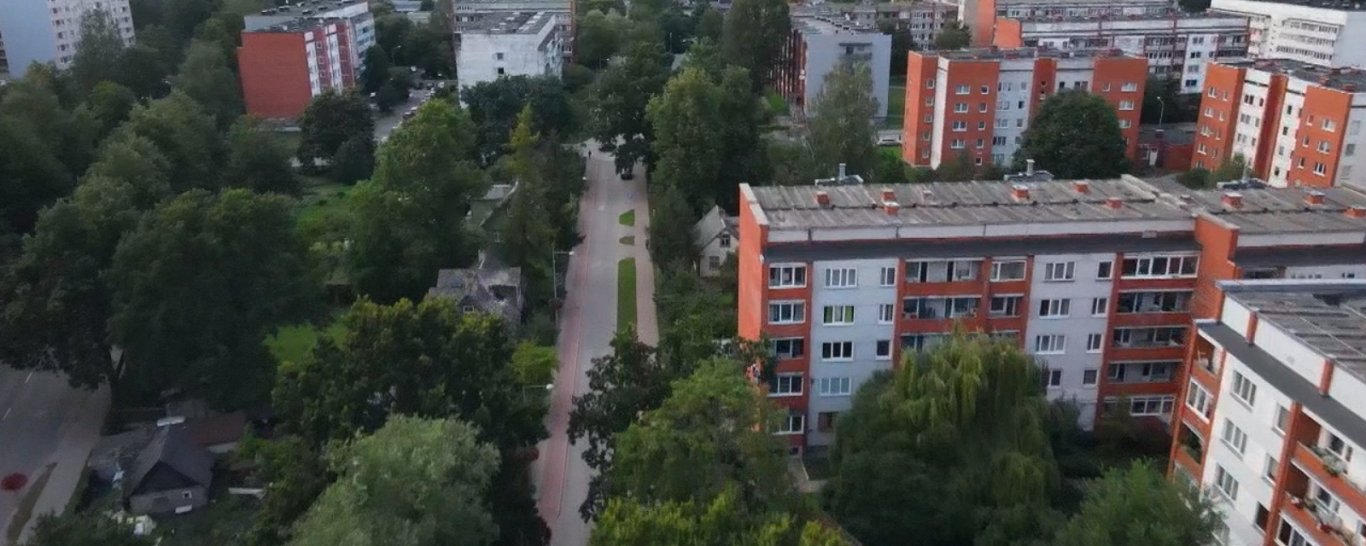Up until now, Kauguri has been a foreign place for me. I have only driven through or passed it by. It's an area of box-like highrise buildings – what's one to do here? And the things I've heard about Jūrmala's "Moscow suburb", starting from the Soviet era, have not made me interested in getting to know this place better. The only stops I had made before were the mall and the famous and truly colorful Kauguri market. Of course, I've stopped at the Kūriņš as well, but the cozy inn is actually part of Kaugurciems, not Kauguri.
But I have noticed that Kauguri has gained a lot visually in the past few years, in the form of greenery, flowers, benches lining the Raiņa street, the Zīmuļu park and the stadium. Perhaps the Ielas garumā (Down the Street) show should go here, as we had already covered neighboring Sloka and Ķemeri? Then Inga Sarma, a historian at the Jūrmala Museum, suggested as we were having a chat that we should do so indeed. She had graduated from the well-known Jūrmala 1st Secondary school, the current Jūrmala State Gymnasium. A number of politicians, journalists, actors, and world-travelers come from this school, but only a few of them remain in Kauguri. At some point in time Inga, too, found the condiitons of a nine-story highrise too harsh for her as well and she moved across the Lielupe river.
But according to Inga one could find traces of different eras across Kauguri, while the buildings, made in the 1950s, on Nometņu and Lībiešu streets in the so-called "Stalin style" with elements of national romanticism are a true treat to architecture historians. The population has also shifted, with Kauguri attracting people from Rīga and other areas of Jūrmala, such as Dubulti, Bulduri and Majori.
This seemed intriguing enough. All I had left was to find interesting companions, and as it has happened on many a street, I chanced upon such people. It turned out that the Liepiņu family, featured in an older show, is living in Kauguri, and they have lived in a five-story, nine-story building and a private home. Dace Liepiņa has graduated the Jūrmala State Gymnasium on Skolas street. After lessons, she and her brother and sister used to go across the to eat pancakes at their grandmother's.
Dace's grandmother Veronika Pozņiaka has been living in the top floor of a nine-story building, but her ties to Kauguri have lasted for an almost entire age. Her mother, fleeing post-war plight and destitution at a kolkhoz in Aglona, eastern Latvia, arrived in nearby Kūdra with her seven children.
"As belongings we only had what we were wearing, and our riches were stashed in our bellies," Veronika says, referring to the fact her mother was not paid wages at the kolkhoz.
The toiling work at the Ķemeri peat bog, and the harsh circumstances they had sharing a wooden barrack with nine other families hardened the children early in life. But it also meant the future could only be brighter. They all went to the Ķemeri school, while Veronika's first memories of Kauguri are related to the open-air dancefloor and taking walks at the seaside. In the early 1950s when they started building two-story houses on Nometņu street, she partook in construction, working odd jobs such as delivering and sorting bricks, and afterwards she worked at the workers' dormitory and the concrete factory in Kūdra.
She only moved to Kauguri in the early 1980s. The workers' barracks had deteriorated already, but the families needed new housing. The factory started building its own nine-story house in Kauguri. Some say it was made using locally-made but defective bricks. The quality was awful but in order to get the keys to the apartment tenants had to sign a waiver saying they have no objections against the quality. Such were the rules in the Soviet era, and everyone made their home more cozy using any means they had.
Until the entire building was occupied, they didn't have an elevator. Veronika, her husband and their 14-year-old son had to carry their belongings all the way to the top. They would have had to pay any helpers but they didn't have any money to spare. "We were very happy all the same," Veronika said. "Finally we had our own home with all the amenities."
The grandchildren would later rejoice seeing the lights of the new Lielupe bridge and tried to outrun their parents and grandmother using the elevator.
Veronika Pozņiaka has lived here for 35 years. The cherry trees they planted beside the building have grown into mighty specimens. They've seen the nearby gravel road morph in to the current Skolas street, and their backyard has finally been beautified too.
Her granddaughter Dace is living in a nearby private home, but Veronika wouldn't change her house for the world. "I have it good here," she says.




























